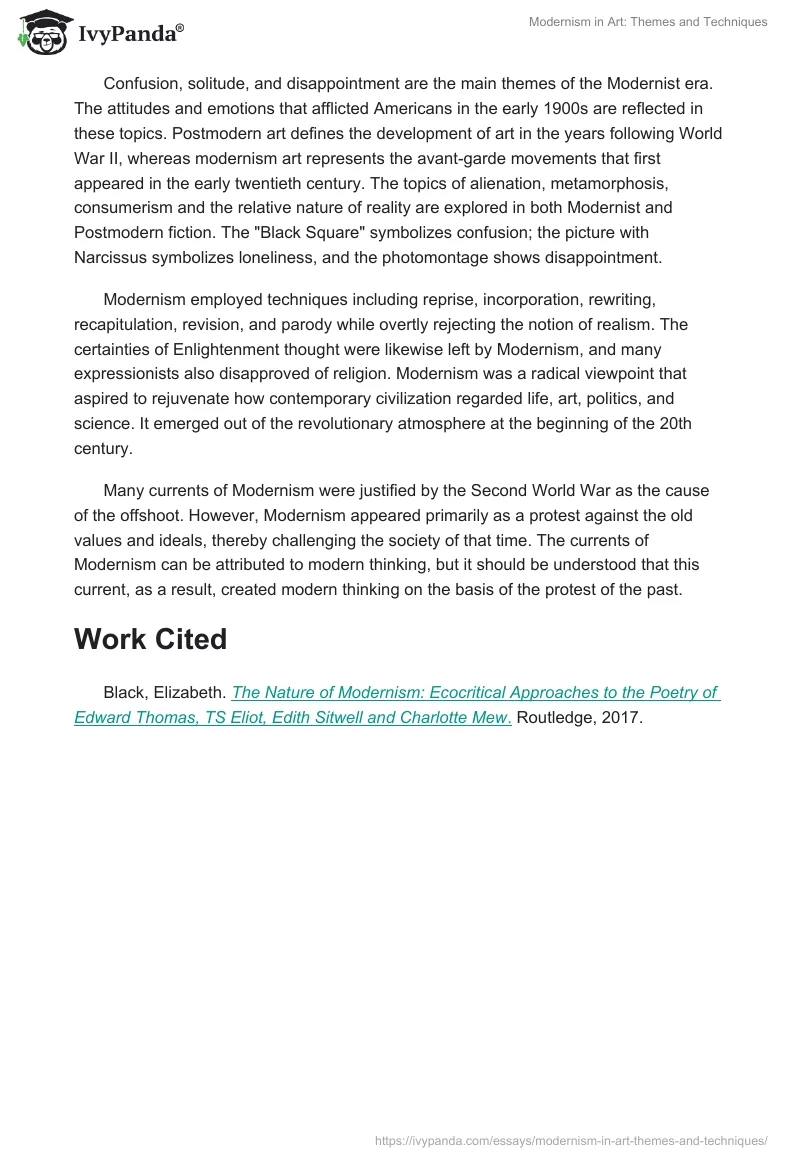The Enlightenment worldview, which centered on the person and gave great weight to reasoned decision-making, defined the Modern Age. During this time, capitalism, imperialism, democratization, and science-based rationalism all witnessed significant growth. To express their unique perspectives, modern artists abandoned traditional approaches to philosophy, color, and design. Scientific advancements that made them doubt the stability of the “actual” world and the accuracy of experience strengthened their views.
The Black Square is a symbol for art generally, not only the first artwork of a grassroots venture. In 1915, Kazimir Malevich created his first Black Square (Black). Given that it distinguishes between realistic paintings and abstract paintings, it is one of the foundational pieces of contemporary art and of Western art and artists. The square was deemed a work of Suprematism by Malevich, a style he announced but which is virtually solely linked to his own output.
Dali’s depiction of the Greek fable of Narcissus is depicted in this artwork. A young man of outstanding beauty named Narcissus destroyed the hearts of numerous lovers because he only cared about himself. In order to show Narcissus’ transition from the kneeling figure in the water into the hand clutching the egg and flower with a hallucinogenic effect, Dali employed a careful method that he referred to as “hand-painted color photography.” Narcissus poses in the backdrop as he did before his shift. Dali’s concern with illusion and delusion gave rise to the play with “double visions.”
Photomontage was created by Hausmann, a founding member of the Berlin Dada movement, as a satirical and subversive protest technique. Although a stamp identifies the “art critic” as George Grosz, another member of the team, the image was presumably taken from a magazine and was cut out in anonymity. The critic appears to be under the grip of capitalist interests, as suggested by the piece of a German bill hanging around his neck. The background text is a portion of poetry that Hausmann created for Berlin’s ramparts.
Confusion, solitude, and disappointment are the main themes of the Modernist era. The attitudes and emotions that afflicted Americans in the early 1900s are reflected in these topics. Postmodern art defines the development of art in the years following World War II, whereas modernism art represents the avant-garde movements that first appeared in the early twentieth century. The topics of alienation, metamorphosis, consumerism and the relative nature of reality are explored in both Modernist and Postmodern fiction. The “Black Square” symbolizes confusion; the picture with Narcissus symbolizes loneliness, and the photomontage shows disappointment.
Modernism employed techniques including reprise, incorporation, rewriting, recapitulation, revision, and parody while overtly rejecting the notion of realism. The certainties of Enlightenment thought were likewise left by Modernism, and many expressionists also disapproved of religion. Modernism was a radical viewpoint that aspired to rejuvenate how contemporary civilization regarded life, art, politics, and science. It emerged out of the revolutionary atmosphere at the beginning of the 20th century.
Many currents of Modernism were justified by the Second World War as the cause of the offshoot. However, Modernism appeared primarily as a protest against the old values and ideals, thereby challenging the society of that time. The currents of Modernism can be attributed to modern thinking, but it should be understood that this current, as a result, created modern thinking on the basis of the protest of the past.
Work Cited
Black, Elizabeth. The Nature of Modernism: Ecocritical Approaches to the Poetry of Edward Thomas, TS Eliot, Edith Sitwell and Charlotte Mew. Routledge, 2017.


